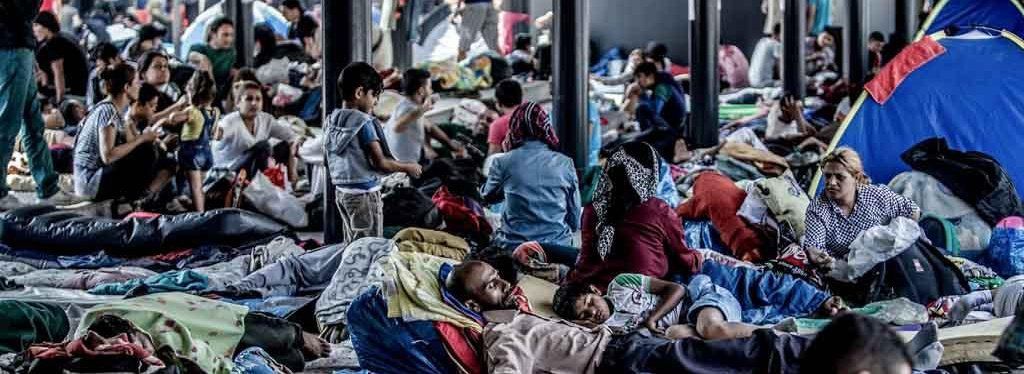Imagine — if You Can — the Desperate Plight of Refugees at Our Southern Border, Part 1
Imagine leaving everything behind, walking miles in all kinds of weather from your home country in Central America, through mountains and deserts, hitching a ride atop a train, hungry or thirsty. Your only possessions are the clothes you are wearing and maybe what you can carry in a tattered backpack. You haven’t bathed or changed your clothes for days or weeks depending upon the distance. You are faced with a staggering array of threats from thieves or rapists, as well as with hunger, loneliness, and death. Some pay a “coyote” thousands of dollars to supposedly bring them safely to the U.S. border, only to be abandoned. You’ve braved everything in order to escape to seek asylum, buoyed by a dream of a better life for your family and by the hope that with the new United States administration, your dreams will be realized.
Imagine sending your child or children alone along those treacherous routes so they wouldn’t be recruited into a gang, become trafficking victims, or experience other violence. Termed “unaccompanied,” in fiscal year 2020, more than 76,000 minors from Central America were apprehended by U.S. Customs and Border Protection (CBP). Mexico detained about 41,000 underage migrants. Children interviewed said they knew the trip was dangerous and if they were caught they could end up in overcrowded, dirty facilities on both sides of the border, without adequate food, water, or health care. But they took their chances anyway to escape dead-end poverty, violence, and lack of opportunities to study or work.
Imagine leaving your wife and children and carrying your nine-year-old daughter over 1,500 miles from Honduras to a U.S. port of entry in South Texas, seeking to escape violence and get medical care for your daughter. Luis’ daughter, Dayana, (not their real names) weighs about 66 pounds and was born with spina bifida, a birth defect which affects her ability to walk and hold herself up. She suffers from convulsions, has a catheter and other ailments including fluid in the brain, and needs surgery.
Imagine attempting to cross and being turned away at the border three times and being turned away due to a little-known provision of U.S. health law. The former administration invoked section 265 of U.S. Code Title 42 to achieve its goal of shutting the border; this section permits the Director of the Center for Disease Control and Prevention to prohibit the introduction of individuals into the U.S. when the Director believes that “there is serious danger of the introduction of [a communicable] disease into the United States.” On his third attempt, Luis paid smugglers the last of his money, they boarded a raft with two dozen other migrants, and floated across the Rio Grande River into Brownsville, Tex. After being fingerprinted and rejected a third time, they were returned to Reynosa, Mexico where they live with approximately 700 other asylum seekers still living on the streets in makeshift tents with no running water or sewerage, a crime-ridden area laced with cartel activity, kidnappings, and violence typical of South American countries.
A March 2020 U.S. Department of State report states: “In Honduras, there are an estimated 7,000 to 10,000 gang members of an approximate population of ten million people… gangs are not reluctant to use violence, and specialize in murder-for-hire, carjacking, extortion, and other violent street crime… violent transnational criminal organizations are also involved in narcotics trafficking and other illicit commerce. Drug trafficking and gang activity, which includes local micro-trafficking of narcotics and extortion, are the main causes of violent crime in Honduras.”
Imagine the desperation, the fear, and the courage of the thousands of asylum seekers continuing to make the journey from Central America’s Northern Triangle — Guatemala, El Salvador, and Honduras — living on Mexican streets near the U.S. border because shelters are filled, and being afraid to leave, hoping this administration will allow them to seek asylum in the United States.
Sources:
“Backlog at U.S. immigration courts getting worse, new research finds,” Border Report, Sandra Sanchez, June 15, 2021.
https://www.borderreport.com/hot-topics/immigration/backlog-at-u-s-immigration-courts-getting-worse-new-research-finds/
“Migrant encounters at U.S.-Mexico border are at a 21-year high,” Pew Research Center, John Gramlich, Aug. 13, 2021.
“Detentions of Child Migrants at the U.S. Border Surges to Record Levels,” The New York Times, Pauline Villegas, Nov. 5, 2019.
https://www.nytimes.com/2019/10/29/world/americas/unaccompanied-minors-border-crossing.html
“Disabled migrant girl whose father carried her most of the journey from Honduras allowed to seek care in U.S.,” Border Report, Sandra Sanchez, May 10, 2021.
“Photo of Drowned Migrants Captures Pathos of Those Who Risk It All,” The New York Times, Azam Ahmed and Kirk Semple, June 25, 2019.
https://www.nytimes.com/2019/06/25/us/father-daughter-border-drowning-picture-mexico.html
Jessica Clark is a graduate of the University of Maryland School of Journalism. After a 30-year career as a Public Information Specialist and photojournalist for several federal government agencies in Washington, D.C., she retired to Georgetown, Delaware. She restored former Governor John Collins’ 1790s home on Collins Pond, volunteers for and promotes several nonprofits in local newspapers, teaches English as a Second Language in James H. Groves Adult High School, and is a Sussex County Master Gardener.
Common Sense for the Eastern Shore








